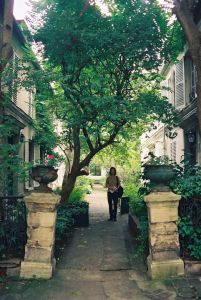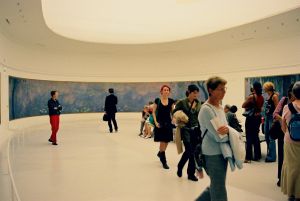CHANGING MUSEUMS AND GALLERIES
by
Paul Bentley
Article
originally published in Museum Matters December 2006 and reprinted with kind permission of the
publishers Museums Australia Inc NSW.
Change is a river that carries many boats.
In November, museum directors from NSW and the
ACT checked the flow of the river - and some of the boats - at a forum
organised by Museums and Galleries NSW and the Museum of Sydney. In Times of
Change: New Developments, arts consultant and broadcaster, Andrea Stretton,
teased out views on changes affecting museums and galleries from a panel
comprising Louise Douglas (National Museum of Australia), Dr Kevin Fewster
(Powerhouse Museum), Frank Howarth (Australian Museum), Andrew Sayers
(National Portrait Gallery), Nick Mitzevich (Newcastle Regional Art Gallery)
and Fiona Winning (Performance Space).
Andrea posed two questions to the panellists:
what are the biggest changes they face in their jobs and how are they dealing
with the challenge? Several themes emerged.
Research
Research has underpinned museum operations for
centuries. It stimulated exploration in eras when much of the world waited to
be discovered. It has informed the stories behind museum objects. The
Australian Museum’s annual Eureka Prize reflects this tradition.
Now, an appreciation of market research and the
benefits of mixing hard data with questionable opinion is causing
organisational change in some institutions. According to Louise Douglas, an
emphasis on research at the National Museum of Australia (NMA) is leading to
organisational changes there. NMA priorities have been reordered. Some
services have been cancelled or scaled back. The NMA and Australian Museum
have embarked on a collaborative audience research project.
The changing nature of museum audiences has
also attracted the eye of Nick Mitzevich at Newcastle Regional Art Gallery,
where the different motivations of those under the age of 45 now figure in the
gallery’s development plans normally geared to satisfying “the constant
over-50s”.
Buildings
 |
| The quietly uplifting stroll to the
front door of the Foundation Dubuffet gallery. Photo: Bentley
|
A spate of building projects is causing some
directors to reflect on museum roles, the nature of the experience they
provide, and changing workforce dynamics.
A new National Portrait Gallery building is
scheduled to open in December 2008. For Andrew Sayers, this has meant dealing
with creative tensions between staff, architects, government, board, builders
and others. It has also meant grappling with the conundrum of whether to make
the museum an architectural statement or to suppress architectural
flamboyance. In his view, a good front door and a pleasurable museum
experience are more important than a seductive building.
A good front door is also important to Nick
Mitzevich. He is leading the charge for a new regional gallery building in
Newcastle and was surprised to learn from street surveys conducted outside the
present building that a large number of people not only didn’t know about the
front door was but didn’t know where the gallery was. To garner support for
the new building, his challenge has been to get buy-in from councillors and
business people who tend to be preoccupied with more prosaic things. He has
discovered the importance of adopting a business language, of emphasising
commercial return as well as cultural and community benefits.
The Powerhouse Museum is creating a new role
for its remote storage facility at Castle Hill. The museum has found that
combining storage and display functions has stimulated new approaches for
presenting exhibits and engaging audiences. It also bringing forth new
pressures – more donations and more requests for information.
The Australian Museum faces the challenge of
the $40 million redevelopment of a 178 year old building. Frank Howarth’s
recipe for successful museum building projects consists of the following
ingredients: a good masterplan, a persuasive bid for funds, good consultants,
and good communication lacing the whole process.
Apart from the need to handle building projects
with aplomb, maybe there are no firm rules when it comes to designing
exteriors and interiors.
 |
| The new interior of the Orangerie in
Paris serves the contemplative experience of savouring Monet's Water
Lilies and other works. Photo: Bentley |
IM Pei’s pyramid at the Louvre is the best
front door of any museum in the world (although you can also
enter by a side door at the end of a shopping mall). By way of contrast, the
secret garden in front of the hard-to-find Foundation Dubuffet gallery —
behind a typical door of a typical building in a typical street of
Montparnasse — offers a quietly uplifting stroll to a gallery front door.
Frank Gehry’s Guggenheim Museum in Bilboa and
Jørn Utzon’s Sydney Opera House have demonstrated that architecture can pull
an audience all by itself. In many museums, though, modular and adaptable
interiors give satisfying experiences without reference to building exteriors.
Specifications for interiors can quickly date.
The rebuilt interior of the recently re-opened Orangerie is a reminder that
simplicity serves the contemplative experience of savouring paintings.
Whereas
La Mente di Leonardo (the Mind of Leonardo) at the Uffizi in Florence — and
several other gallery exhibitions currently in Europe — hint at new
possibilities for bridging gallery and museum experiences in spaces that owe
more to theatre.
Organisations
Andrew Sayers said that one of the benefits of
a building project is that it focuses the energies of staff on the mission of
the museum when their minds might otherwise be distracted by other things.
Possible distractions exist partly because of
changing dynamics in the museum workforce. According to Kevin Fewster, the
passion of the baby boomers who constitute a lage slice of the museum
workforce makes them too conservative and proprietorial about their ideas.
With the growth of project-based positions and contractors, loyalty to an
organisation is diminishing and corporate memory is increasingly placed at
risk. Museums and galleries need to manage the succession from one generation
to another.
Other enterprises
Fiona Winning was the one panellist who didn’t
work in a museum. She was a reminder that ideas for working museums can be
found in other enterprises. As Director of Performance Space, she is leading
her 25-year old company of 12 staff through the process of relocating to a new
precinct and of forging relationships with other resident companies in
Carriageworks, a $45 million state government funded centre for contemporary
dance, music and theatre in the old Eveleigh rail yards in Sydney.
The loss of a dedicated space and the loss of
autonomy led initially to a sense of disempowerment, which has now given way
to a feeling of liberation as they map out uncertain territory with new
players. No-one quite knows how Carriageworks will evolve. Creating a new
future has therefore solicited openness and experimentation rather than a
fixed plan, project management techniques and the comfort of past experience.
Influence
Kevin Fewster drew attention to the importance
of social contexts for museums, which need to adopt a leadership role on many
subjects.
Mentioned in passing at the forum, the theme
has been fleshed out in the latest MAG magazine. Fiona Cameron, a research
fellow with the Museum and Cultural Heritage Studies Centre for Cultural
Research at the University of Western Sydney, in her article Safe Places for
Unsafe Ideas said: “Our research suggests that many museums have a strong
moralising and reforming task to perform as a system of social, cultural and
self-development. On the one hand, audiences want an open debate and range of
perspectives; on the other hand they require museums to set moral standards
and reforming agendas that can be used to understand and evaluate societal
conduct.”
In the same issue, Calab Williams from Sydney’s
Justice and Police Museum put it another way: “Ideally museums should be
places of light, where the dark, the difficult and the problematic can be
admitted, freely debated and made visible in an environment that feels safe,
non-exploitative, open, friendly and philosophically expansive.”
Government policy
Political contexts are no less important. The
proposed amalgamation of the Powerhouse Museum and Australian Museum,
described by Andrea Stretton as “the elephant in the room” was a silent
reminder of the influence of Governments on museum strategy and operations.
Both Kevin Fewster and Frank Howarth,
understandably, refrained from premature comment about developments, leaving
the debate to others. But they did reflect on changing government
expectations. In the major museums, there is an expanding requirement for
self-generated income (now 25-40% instead of 10%) and ongoing pressures for
more efficiency. Museums need to live with the realities of limited government
funding and the competition for government funds from areas like health,
education and roads. For Frank Howarth it means emphasising relevance. For
Kevin Fewster it means exploring new relationships and being adaptable.
Not mentioned in the panel discussion was the
emergence of the Collections Council of Australia (CCA) and the converging
interests of museums, galleries, archives and libraries.
Modelled to some extent on the Museums,
Libraries and Archives Council (MLA) in the UK and the Institute of Museum and
Libraries Services in the US, the CCA has been set up with less funding — in
the words of CEO Margaret Birtley — to identify and support innovative and
accountable ways in which collecting organisations might evolve.
Since 2001, the MLA has produced numerous
reports on information and communications technology, benchmarks and
performance indicators, visitors, educational roles, digital preservation,
regional infrastructure and other subjects relevant to the four domains.
In 2002, it assessed the museum world in the UK
as one in which where there was no common understanding, there was a high
level of uncertainty about a range of issues, and there was tension about the
different needs of large institutions and small, independent and volunteer-run
museums.
Building on the generic advice in these
reports, the CCA has got off to a flying start in defining local needs.
National consultations and surveys are under way on collecting facilities and
the development of regional hubs. Its report A Survey of Human and Financial
Resources in Australian Conservation and Preservation, not surprisingly, found
that there is a shortage of funds for collecting organisations to achieve a
range of reasonable conservation and preservation goals, a shortage in the
availability and suitability of conservation and preservation workers, and the
probability that shortages of skilled conservation staff will intensify. Faced
with competing demands of deteriorating collections, increased public access,
and rapid technological change, it has recommended the development of
integrated education, training and workforce planning by the four domains,
promoting needs to appropriate stakeholders, and further research.
Information technology
Most panellists viewed information and
communications technology as one of the main challenges and one of the main
opportunities for museums and galleries.
Frank Howarth urged the audience to embrace it,
but not to become a slave to it. “Watch out for bandwagons,” he said, “and
balance the real with the virtual.” The Australian Museum website now attracts
24 million visits annually, compared with 300,000 who come through the front
door. At the Powerhouse Museum, which is in the process of making available
70,000 digital objects online, web usage has increased threefold in last 6
months. Louis Douglas warned that online hits don’t necessarily lead to museum
visits. And it is probably also worth pointing out that only a small
percentage of website visitors will be satisfied ones.
The Institute of Museum and Library Services
has just published its report Status of Technology and Digitisation in the
Nation’s Museums and Libraries assessing the state of play in the United
States. No doubt mirroring the circumstances in Australia, the survey reported
dramatic progress in use of technology and digitisation activities since the
previous survey in 2001, although small museums and public libraries still lag
behind their larger counterparts. The larger libraries and archives still lead
the way. Many technology and digitisation activities are not supported by
institutional plans and policies. While collaborative digitisation efforts are
underway, they are not yet widespread. Only a small proportion of museums and
libraries assess user and visitor needs for digitising collections and
services.
The lack of business plans, poor coordination,
and competing interests echo conclusions in numerous other reports published
over the past few years — such as Diane Zorich’s A Survey of Digital Cultural
Heritage Initiatives and Their Sustainability Concerns for the Council on
Library and Information Resources in the US, reports relating to the National
Information Infrastructure and Preservation Program managed by the Library of
Congress, and the European Commission’s Digicult Report.
The CCA has set a course to build on past
Government-led efforts going back to the Creative Nation agenda and subsequent
Ozeculture conferences, among other Australian initiatives. Its Summit on
Digital Collections, held in August, took stock of activities in libraries,
archives, museums and galleries and a report it is expected soon. This will no
doubt encourage museums, lagging behind the other domains, to tool up by
developing websites and systems, as well as give some direction to the more
critical area of interoperability and managing structural, descriptive,
preservation and administrative metadata in a cross-sectoral world.
Summing up
Are today’s changes any different to
yesterday’s changes? It was a question posed by Andrea Stretton, but, with
time running out, was a question not fully explored.
For many working in today’s topsy-turvy word,
change can be as daunting as that experienced by Billy Budd, when he was
transferred from the happy atmosphere of the Rights-of-Man to the poisonous
environment of HMS Indomitable, before meeting an ironic fate at the hands of
the jealous, enigmatic Master Clegg.
The American comedian Milton Berle once implied
that change is over-rated: “I’ve been in this business for a long time — I was
on television when it was called radio.”
The management guru Charles Handy, in The Empty
Raincoat, drew on the sigmoid curve to explain the ebb and flow of
civilisations, countries, companies and personal relationships. .
 |
| The sigmoid curve |
Things begin slowly, experimentally, then they
wax and wane. By the time they reach point A, people travelling up the path
must exercise forced discontentment and reinvent themselves to avoid point B
and find the next sigmoid curve. The past is not necessarily the best
fertiliser of the next curve, but it should not be abandoned too quickly. New
directions draw on continuity. New ideas must co-exist with the old.
For Picasso, discontentment was part of a
routine: “I’m like a river that rolls on, dragging with it trees that grow too
close to the banks or dead calves one might have thrown into it or any kind of
microbes that might develop in it…it’s the movement of painting that interests
me.”
For collecting institutions, the impetus for
change can give rise to unrealistic expectations.
MLA has already alluded to its limited capacity
for making a difference in the converging world of museums, galleries,
archives and libraries.
Change will only work, it says, if supported by
all the stakeholders. “Some goals will take years to reach and there will
undoubtedly be setbacks along the way. The profession will need perseverance
and determination to work its way through them.”
Further reading
Birtley, Margaret. Linking the nation's memory:
progressing the work of the Collections Council of Australia (reCollections
(National Museum of Australia), v.1 no.1 Mar 2006: 83-91).
Collections Council of Australia. Conservation
survey 2006: a survey of human and financial resources in Australian
conservation and preservation / VM Bullock, MM Birtley, CJ Jenkins. Available
from http://www.collectionscouncil.com.au.
Institute of Museum and Library Services.
Status of Technology and Digitization in the Nation’s Museums and Libraries,
2006. http://www.imls.gov.